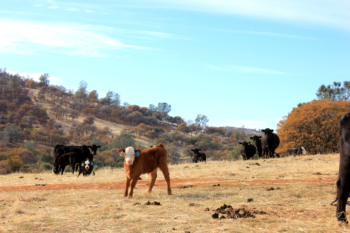National attention for the California drought
California's deepening drought woes were shared with the nation over the weekend in an article by New York Times reporter Adam Nagourney. The story noted efforts by UC Cooperative Extension to help ranchers survive the crisis.
UCCE and the UC Sierra Foothill Research and Extension Center joined forces last week to provide ranchers with information they need to make tough decisions about the future of their cattle. According to the caption of one of the photos in a 10-image slide show accompanying the NY Times story online, four-foot-high grass typically blankets rangeland areas where now only short brown stubble can be found.
Three photos in the slide show were taken during the field portion of the day-long UC workshop on drought survival. They include:
- UC Davis veterinarian Nancy Martin speaking to ranchers about keeping herds healthy
- Browns Valley rancher Terry Stevens
- Cattle ranchers examining an alternative type of feed
The Times story also quoted Jeremy James, director of the Sierra Foothill REC.
“We have people coming from six or seven hours away,” he said. More than 100 ranchers attended the event.
In addition, the Browns Valley workshop was webcast live to seven locations around the state where ranchers gathered at UC and farm bureau offices, and to dozens of individuals. One of the individuals was Tim Hearden of Capital Press. He followed up with a 600-word article containing pertinent advice from UC Cooperative Extension to concerned ranchers. A key point he reported came from Roger Ingram, UC Cooperative Extension advisor in Placer and Nevada counties.
“Number one, never try to feed yourself out of a drought,” Ingram said. “It can bankrupt you financially and … it can bankrupt you ecologically."
Other important points from UCCE mentioned in the article were:
Consider weaning early to boost cows' efficiency. A cow that stops feeding sees a spike in energy to prepare for the next calving season. - Josh Davy, UCCE advisor in Tehama, Colusa and Butte counties
Producers with limited water should remember that irrigated pasture is thirstiest during the summer and not as much in the fall. - Larry Forero, UCCE county director in Shasta County
Younger cow-calf operators should seek advice from those who made it through the last catastrophic drought in the mid-1970s. - Glenn Nader, UCCE advisor in Yuba, Sutter and Butte counties


